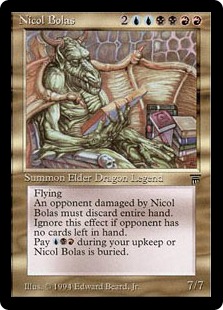The Reserved List: Its History, Its Future, and the "Foil Loophole"
The Reserved List may be the most controversial three words in all of Magic. Created all the way back in 1996, the list has been the subject of debate from the day it was created, and now, nearly 25 years later, it continues to cause discussions (and problems). The list, containing a total of 572 cards that Wizards has promised to never reprint, is in large part responsible for the extremely high price of some staples of formats like Vintage, Legacy, and—most importantly in 2020—Commander. However, the Reserved List itself tends to be greatly misunderstood in several ways. As such, today, we're going to delve into the Reserved List, break down why it exists, dispel some myths about what it does and doesn't do, and look at what might be the easiest way for Wizards to start printing cards from the Reserved List while avoiding potential legal pitfalls.
The Creation of the Reserved List

Perhaps the most common misconception people have about the Reserved List is that it was a mistake. While it is true that the effects of the Reserved List are almost all negative for the average Magic player today, if we take a time machine back to 1996 when the list was created, the Magic world looked very different. Magic was a much, much smaller game, rather than the behemoth it is today. There was no certainty that the game would exist the next year, let alone 25 years later. If you look at other similar games, most quickly died off. Magic could easily have experienced the same fate.
In this context—as a new game with an unsure future—we have Chronicles, the first mass reprint set in the game's history. While today, we expect reprints on a yearly or even monthly basis, and much of the player base clamors for more reprints of in-demand staples, at the time, the idea of a high-supply reprint set was completely new. Chronicles took many expensive and in-demand cards from the first years of Magic and didn't just reprint them but reprinted them into the ground, with some cards reprinted in the set falling in price from $50 down to just a couple of dollars. The supply of the set was so high that even today, 25 years later, few of the cards have any value.


Watching card prices drop in such an extreme matter from such a high-supply reprint set caused a backlash from collectors and some players. Wizards, fearing for the game's very existence, took swift and bold action, announcing a new reprint policy and the creation of the Reserved List. Originally, the Reserved List promised not to reprint any cards from Alpha or Beta, any uncommons or rares from Arabian Nights and Antiquities, or any rares from Legends or The Dark that had not already been reprinted in white border (in the early days of Magic, white borders were used to represent reprints). Furthermore, for future sets, Wizards would reprint no more than 25% of the rarest cards from the set. ("Rarest" reads strangely in 2020, but at the time, Magic rarity wasn't as clear as it is today. But once rarity was normalized, this meant that 75% of the rares from a set would go on the Reserved List and the other 25% would be available for reprints.) The list would be updated with each new core set, so collectors and players would know which cards from previous sets would have the potential to be reprinted and which cards would not.
One of the most common misconceptions about the Reserved List is that it was a mistake, but this probably isn't true. As someone who has mostly interacted with Magic as a massive game with millions of players, digital clients, and a whole universe of content producers and websites, it's hard for me to imagine the game dying. At this point, Magic almost seems too big to fail (which is probably a good thing, considering some of the cards Wizards has printed and decisions it has made over the past couple of years), but this certainly wasn't the case in 1996. While we can't know for sure how an alternate universe without the Reserved List would have played out, there is little doubt that the odds of Magic existing today, 25 years later, would be lower.
If the Reserved List was a mistake, the mistake wasn't that it was created. In the context of its time, it was very likely necessary to keep the game alive. The mistake was that even Wizards had no idea what Magic would become—that the game would grow, have millions of players, and still be thriving 25 years later. The Reserved List solved an existential crisis back in 1996, but because it promised that the cards on the list would "never" be reprinted (and because Wizards has mostly kept this promise for 25 years), it has ended up causing problems in the decades since as we are stuck with a supply of Gaea's Cradles, Underground Seas, and Lion's Eye Diamonds befitting a game with hundreds of thousands of players for a game that now has 20 million.
Basically, the Reserved List was necessary to solve a short-term problem back in 1996. Wizards went too far with its first-ever reprint set in Chronicles by reprinting cards too heavily, which crashed the market; as a result, it was forced to promise not to reprint as many cards. The problem is that the solution was shortsighted (understandably, as not many people in the mid 1990s—including Wizards—would have predicted that Magic would grow into what it is today) and everlasting. Sort of.
Changing the Reserved List
While the anti-Reserved List crowd tends to have the misconception that the Reserved List was an outright mistake, rather than a shortsighted solution to a very real problem that could have killed the game two decades ago, the pro–Reserved List crowd as a misconception of its own: that the Reserved List is unchanging and that Wizards has held to its promises for the past 25 years. It's true that, for the most part, Wizards has stuck to its Reserved List promise and hasn't mass-reprinted the cards on the list. It's also true that the Reserved List as a reprint policy has been a living, changing document over the past 25 years.


Demonic Tutor was the most important card removed from the Reserved List in 2002. Its original printing seems to be holding up alright despite many, many reprints over the past 18 years. And these reprints allow Demonic Tutor to be one of the most played and popular cards in Commander by keeping its price accessible to players of all budgets.
The first big change to the Reserved List happened in 2002, when Wizards decided to end the Reserved List with Mercadian Masques, so all cards first printed from Masques forward would be eligible for reprinting with no restrictions. At the same time, Wizards removed commons and uncommons from Alpha and Beta from the Reserved List, due to "overwhelming public support for this change," with a massive 91% of poll respondents saying they wanted cards removed from the list.
The importance of this change should not be underestimated. While proving that cards can come off of the Reserved List is a big deal in and of itself, perhaps more important is the reason: Wizards stated, in black and white, that community support for the change made it happen. This flies in the face of the argument that occasionally comes up from the MTG Finance community (many of whom have a vested interest in the Reserved List) saying we should simply stop talking about the Reserved List and accept its currently detrimental impact on the game. If Wizards removed cards from the Reserved List once thanks to "overwhelming public support," it seems possible that, with enough of a push from the community, it could happen again.



The second major change to the Reserved List happened in 2010, after Wizards reprinted some Reserved List cards as foils in Duel Decks and From the Vault releases. Originally, the reprint policy made an exception for premium versions of cards, which Wizards took advantage of by printing Phyrexian Negator in Duel Deck: Phyrexia vs. the Coalition; Karn, Silver Golem, Masticore, Memory Jar, and Mox Diamond in From the Vault: Relics; and Phyrexian Dreadnought, Morphling, Thawing Glaciers, and Wheel of Fortune as judge foils. According to Mark Rosewater, these reprintings upset the silent majority of Magic collectors, and Wizards once again changed the reprint policy, this time to include premium versions of cards.
The so called "foil loophole" is especially interesting and might be the easiest way to solve our current Reserved List–driven price problem. One of the biggest debates in the community is whether or not the Reserved List is a legally binding promise: could someone with a huge collection of old Reserved List cards sue Wizards if it started reprinting cards on the Reserved List? While the answer is up for debate—and even lawyers have differing views, with some saying that Wizards would almost certainly be brought to court, while others saying that even if that did happen, the lawsuit would assuredly fail—the fact remains that the original Reserved List promise didn't include premium (foil) cards. No one bought a Black Lotus back in 1998 based on the promise it would never have a premium printing because that promise didn't exist. As such, the easiest and simplest way to increase the desperately needed supply of Reserved List cards would be to reinstate the "foil loophole," which would allow Wizards to print an all-foil Reserved List Masters set. Sure, your newely reprinted Gaea's Cradle might come out of the pack shaped like a Pringle, but at least it wouldn't cost you $800 to play a single land in your Commander deck.


From Wizards' perspective, embracing the foil loophole would have the potential to make the company near-infinite amounts of money. Some of the most in-demand cards on the Reserved List are the original dual lands, which currently range from $200 to $550 for their cheapest printing. Imagine how many copies of a Secret Lair drop featuring original dual lands could sell, even at a high price point. I'm not sure there is any possible Secret Lair drop in all of Magic that would generate as much revenue for Wizards, and this doesn't even include the number of Masters sets Wizards could sell with cards like Underground Sea in the dual-land slot.



Even beyond the dual lands, Wizards could spend the next several years making piles of money selling foil Mox Diamonds, Moats, Gaea's Cradles, and Mishra's Workshops, and these are only the most expensive of the Reserved List cards. Earthcraft is $100. Gate to Phyrexia is $115, and Yawgmoth's Will is $150, and these are cheap for playable Reserved List cards. Reprinted slowly and wisely in premium form, the Reserved List would be a gold mine for Wizards, not just in terms of dollars and cents but also in goodwill with the community as well, which couldn't hurt after how rough the last year has been for most constructed formats.
Conclusion
So, what have we learned today? The Reserved List most likely wasn't a mistake when it was created by a struggling new game company. It's very possible that Magic wouldn't exist today without it. However, the Reserved List has lost its value over the past 25 years. Rather than keeping people playing the game, as it was originally designed to do in the wake of Chronicles, it is keeping people from playing the game as prices of cards on the list—including Commander (the one format that is keeping paper Magic afloat right now) staples—spiral out of control.
The good news is that the Reserved List isn't set in stone. It has been changed multiple times over the years, with cards taken off the Reserved List and subsequently reprinted, thanks—in Wizards' own words—to overwhelming support from the community, and the foil loophole being closed back in 2010, 14 years after the creation of the Reserved List and reprint policy. While simply ending the Reserved List would be the ideal solution for players, there could potentially be some legal and financial risk to Wizards if it chose this path (although whether or not a potential lawsuit would have any merit is hotly contested).



Thankfully, Wizards doesn't need to break the Reserved List to give players the reprints they need. The original Reserved List left Wizards an out thanks to the foil loophole. With the current focus on premium products, it is the perfect time for Wizards to revert back to the original wording of the reprint policy and start printing foil versions of the Reserved List cards that players need in Masters sets, Secret Lairs, and other supplemental products. From Wizards' perspective, this would open up a massive new stream of reprint equity, giving Wizards plenty of in-demand reprints to fill supplemental products for the next several years and probably longer, considering how much demand there is for cards like the original dual lands. Meanwhile, players would finally get access to the cards they need to play formats like Commander and Legacy at a more attainable price point.

What about the collectors who support the Reserved List—Mark Rosewater's silent majority that would prefer their cards remain expensive? The damage that reprinting Reserved List cards in foil with new art and in a new border would cause to their original printings would be, in many cases, minimal. The most expensive cards on the Reserved List come from the earliest years of the game: cards from Alpha, Beta, Legends, Arabian Nights, and Antiquities, primarily. These cards are expensive mostly because they are extremely collectible and have low supply, not because they are playable, and foil reprintings wouldn't change this at all. Birds of Paradise and Shivan Dragon are two of the most expensive Alpha cards, ahead of many of the dual lands, and these cards have been reprinted infinite times, to the point where Shivan Dragon now shows up in precon decks given away to new players for free. Despite this, the originals still cost thousands of dollars. It's even possible that having cheaper versions of these cards on the market actually increases the price of the older, collectible versions, as it introduces newer players to cards that they have perhaps never even seen before. And some of these players will strive to have the oldest, coolest, and most collectible version.


On the other hand, Reserved List cards from later sets that are expensive mostly because of their playability, rather than their collectibility, would doubtlessly drop in price, perhaps by quite a bit. We have examples of these as well, from older cards that are not on the Reserved List being reprinted. Take Imperial Recruiter. The original Portal: Three Kingdoms version is still $135, more than five times as much as the Double Masters printing, which is just $25. But $135 is a lot less than the $350 it was a few years ago before it was reprinted for the first time. The same is true of cards like Sneak Attack. The original printing still commands a premium, but for cards that are mostly expensive because they are needed for gameplay purposes, being reprinted does drop the price, as some players will pick up the newer, cheaper version rather than the original. All this is to say, while people with big Reserved List collections will lose some value if the foil loophole is reinstated on the Gaea's Cradles and Gilded Drakes of the world, the impact is likely overblown, as the most expensive cards on the Reserved List are expensive because they are extremely rare and collectible, not because they haven't been reprinted.


Most importantly, using the foil loophole to reprint Reserved List cards would bring the reprint policy back in line with its original intention, which was to protect the game and keep it thriving in its current environment. Back in 1996, not reprinting cards was necessary, but it's not 1996 anymore. In 2020—the year of Commander—finding a way to reprint the cards that players need to play Magic's more popular format is needed, whether those cards happen to be on the Reserved List or not. Bringing back the foil loophole and increasing the supply of Reserved List cards through Masters sets, Secret Lairs, and other "premium" supplemental products would be a win for both Wizards and players and likely not as bad for collectors as some would like you to believe.
Wrap-Up
Anyway, that's all for today. Should Wizards bring back the foil loophole as a (hopefully) legally safe way to get around the Reserved List? What other possibilities are there to bring down the prices of cards like Gaea's Cradle and the original dual lands? How would you, personally, feel about the Reserved List ending altogether or being changed to reinstate the original list with the premium loophole? Let me know in the comments. As always, leave your thoughts, ideas, opinions, and suggestions, and you can reach me on Twitter @SaffronOlive or at SaffronOlive@MTGGoldfish.com.













